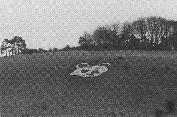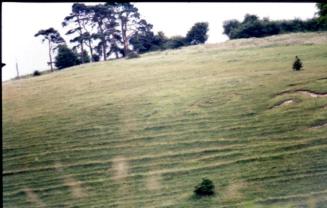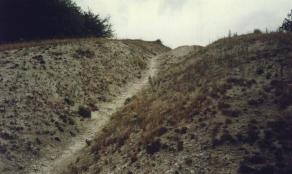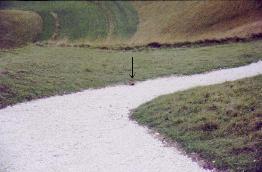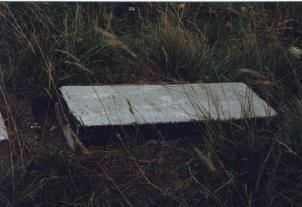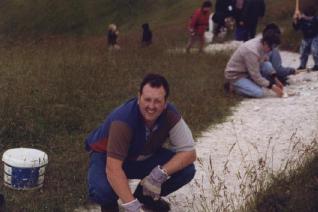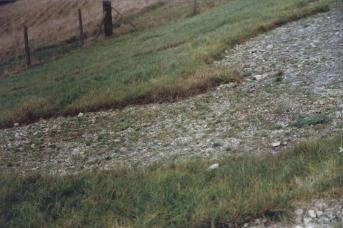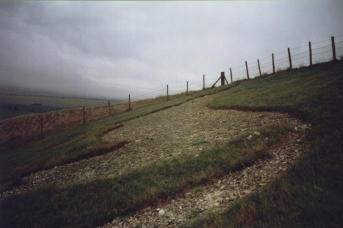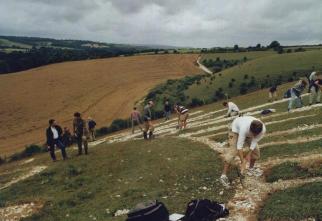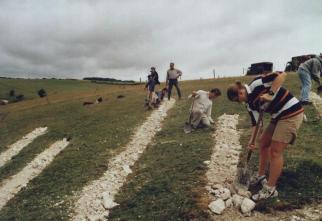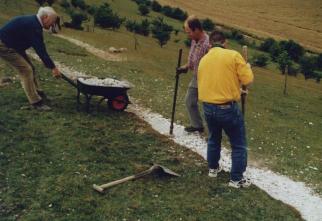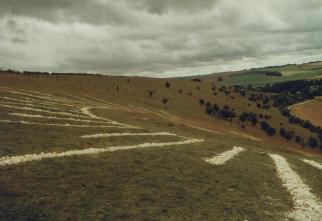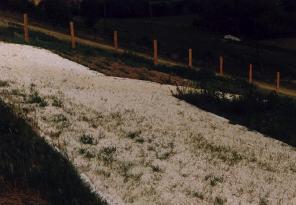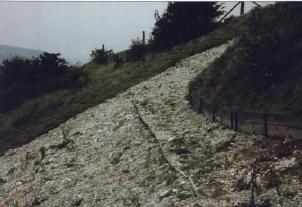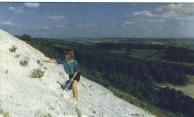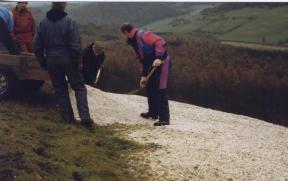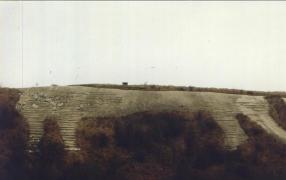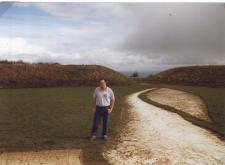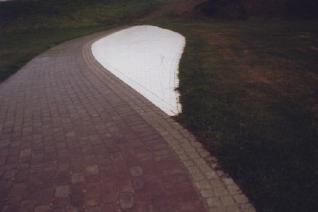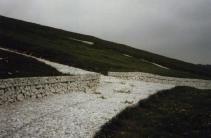Problems
The major problem for hillfigures is the tendency for the natural vegetation to cover the chalk, it encroaches from the edges and can grow on soil washed onto the figure by rain. This can quickly completely cover a hillfigure. The Laverstock Panda has not been scoured for 30 years and is almost lost in the grass.
Laverstock Panda in 1970
Laverstock Panda in 2000
Water Erosion can also be a problem particularly on very steep slopes or on very gently slopes, the rain can wash the chalk off the figure or soil onto the figure. Larger figures are more susceptible to this.
Water Erosion of the Whiteleaf Cross
This can have two effects, if chalk is washed off the figure, then the figure gradually creeps down the slope, if soil is washed onto the figure it collects on the lower edges and the figure gradually climbs up the slope.
Providing adequate drainage is the key to preventing this, either using run off drains as in the Uffington White Horse or I think (and its not been used yet) a French ditch above the figure.
Uffington Drainage
Vandalism can be a problem either accidental or intentional and the damage caused by grazing animals can be problematic and many figures are fenced to prevent this, but the burrowing of rabbits cannot be stopped in this way and causes considerable damage to some figures, the Littlington horse suffers badly from rabbits burrowing into it.
Steep slopes are more susceptible to landslides particularly on thin soil, where as damage caused by visitors is greater on gentle slopes (more visitors) access also effects the visitor pressure.
Fovant Badges Problems
The Fovant Badges have a problem particular to their method of construction, the chalk is thin and on the surface of the ground or just cut into the surface a little. The chalk creeps down the hill as with other figures but due to the nature of their complex design there are ridges of chalk which catch eroded debris forming eyebrows which discolour and distort the figures. Some of the Fovant Badges have suffered badly from this problem. My solution would be to use mesh gabions of chalk to make the figures, this reduces maintenance and prevents this type of erosion.
The Long Man of Wilmington
The Long Man of Wilmington is constructed from concrete blocks pushed into the ground. They may erode very slowly but problems may occur from vandalism and the blocks can be pulled out.
Scouring
Scouring is the name for the process of rechalking a hillfigure. This can be achieved in three ways:-
1) The old chalk may be removed and fresh chalk added, this provides the best result but is the most labour intensive and time consuming. The old discoloured top chalk is removed only a few inches usually. This is then replaces by new chalk and this is usually compacted down although sometimes this is left to mother nature to do. This is only carried out on average (depending on hillfigure and conditions etc.) every 10 or so years.
2) Fresh chalk may be added onto of existing chalk , this gives the same effect for less effort but can only be done a few times as there will be too much chalk in the figure, this is carried out approx. annually.
The Author Scouring the Uffington White Horse
3) Or the chalk turned, in some areas the chalk can become discoloured and simply turning the chalk and recompacting it can rewhiten the figure, this is the easiest method of scouring.
The process also takes into account encroachment of vegetation into the figure, or after rain has washed soil onto the figure it can allow plants to grow on the figure
Plant Growth on the Pewsey Horse
Plant growth can be kept in check on some figures by the application of herbicides, although some figures are in sensitive areas and this cannot be used and hand weeding and application of small amounts of chalk takes place.
Tradition of scouring
The tradition of hillfigure scouring is well documented throughout the ages, and was carried out annually for the Red Horse of Tysoe and every 7 years for the Uffington White Horse until the late 1700's. The act was usually associated with festivities, or in the case of the Cerne Giant a maypole dance. These were religious acts the Uffington festival on the summer solstice and the Cerne festival on May day, the Red Horse on Palm Sunday, but in later history the reasons were lost although the festivals still took place. And the Uffington festival still continues to this day.
Typical Stages of Scouring
The figure before restoration with plants encroaching the edges and growing on the figure
Stage 1 - Weeding.
The weeds are removed from the figure body (The figure was previously sprayed with Weedkiller) and the encroaching plants removed from the edge, note the figure is slightly recessed.
Stage 2 - Adding Chalk
Fresh chalk is added to the trenches
Stage 3 - Tamping
The chalk is hammered down to form a hard surface resistant to weed growth and weather damage.
The finished restoration
Conservation
There have been many measures used to prevent hillfigure erosion, physical barriers have been used to keep grazing animals and visitors off the figures. They have also been used to mark the edges of the figure.
Many hillfigures have their edges shuttered, particularly the lower edges to allow collected soil and chalk to easily be removed. This also provides a barrier against vegetation and clearly defines the edges of the hillfigure when being scoured.
Stone Edging on the Osmington Horse
Edging on the upper edges as on Osmington and Whiteleaf are usually to prevent soil moving onto the figures.
Stone edging on the Shoreham Cross
On some steep slopes the problem of chalk moving down the hill or landslides has been minimised by shuttering across the figure, Littlington and Kilburn are examples of this.
Wooden staging on the Littlington Horse
A further problem is encountered by the Kilburn horse, the figure is made of limestone and this quickly goes grey and the horse is nicknamed the grey mare as it was never really white. Some chalk was added to help this but the effect short lived. The steepness of the slope allows the limestone and chalk to fall down the hill, shuttering has been used with minimal success. Other measures were employed both to whiten the horse and prevent the surface limestone from falling down the slope. A product called Snowchem which is a cement based product is mixed with white paint and sprayed on the horse, it has had some success.
Painting the Horse
Chalking the Horse
The horse looking grey and the the shuttering on the lower parts of the horse
Drastic Measures
These are usually employed when other conservation techniques have not prevented any further damage.
The most drastic is concrete replacement of the hillfigure which was the case for the Westbury Horse in 1957.
Concrete Westbury Horse
Another drastic measure was the replacement of the chalk blades of the Battle of Britain Memorial with Brick ones in 2000, this was purely due to vandalism, youths rode motorbikes (Note the author rides a motorbike) constantly across the figure badly damaging it, and the decision was not taken likely - a real shame.
Chalk Battle of Britain Memorial and the Brick Battle of Britain Memorial
A less drastic measure was the restoration of the Wye Crown in the early 1990's by Donald Sykes, this ingenious idea was to use flint and chalk in metal gabions (cages) these could then be banked up to provide protection from land slides soil wash etc. And scouring was then made easy as a simple whitewashing of the crown and it was back to full glory.
Wye Crown Gabions
